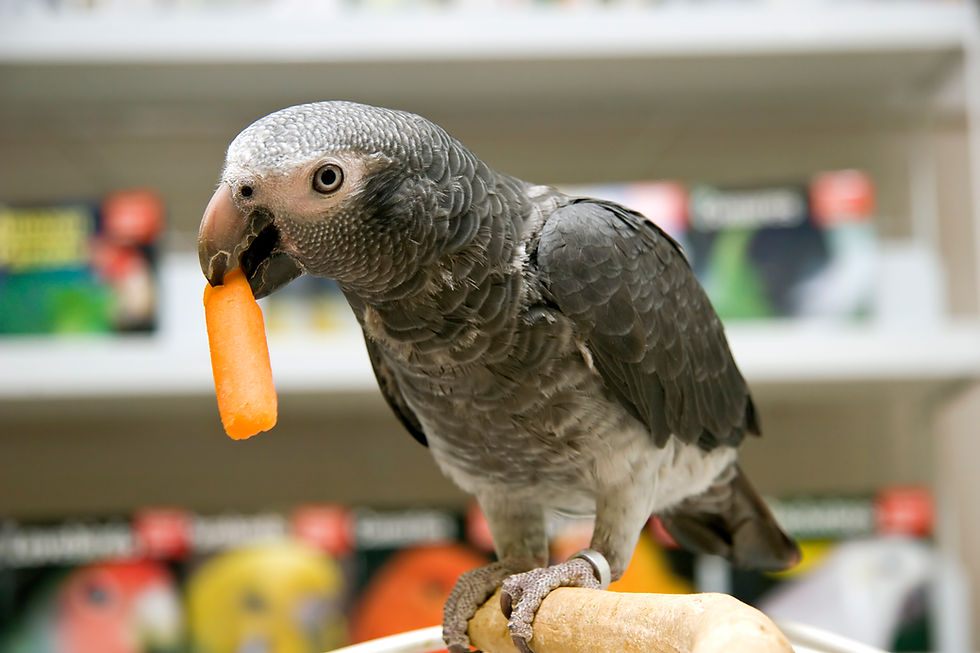Parrot Life Newsletter June 2021
- Parrot Life Behaviour and Training
.jpg/v1/fill/w_320,h_320/file.jpg)
- Jun 10, 2021
- 3 min read


ENRICHMENT INSPO - HOMEMADE PINE CONE FORAGERS
If you are like us you're always looking for new ways to encourage your parrot to forage!
Well here's a great and quick foraging idea that you can whip up using things you already have around the house!
All you need are some parrot pellets, a small amount of seed and a pinecone!

Step 1. Immerse a bowl of pellets in hot water. A ratio of 1:4 pellets to water works best. Leave for 20 minutes until pellets become soft then stir with a spoon to break them down.
Step 2.
Generously smear the wet pellets into gaps on the pinecone. Really work it in. Don't be afraid to get your hands dirty!
Step 3.
Roll pinecone over seed so seed sticks to the exterior!

Step 4.
Refrigerate briefly to firm up and offer to your bird! Alternatively you can make up extras, pop them in snap lock bags and freeze them for later use!
Your birds will love them! These are also a great way to introduce pellets to a bird who typically refuses to eat them!


BRISBANE SEMINAR SERIES with BRISBANE BIRD MINDING!

Parrot Life is excited to be working closely with Brisbane Bird Minding to present a series of seminars on various parrot behaviour, training and care topics throughout 2021!
We held our first seminar last weekend, June 5th, covering the topic of 'Parrot Training Basics'.
Our next sessions will be held on Saturday July 3rd 2021 at the Brisbane Bird Minding facility in Rochedale.

Contact Toni at Brisbane Bird Minding for full details and bookings! toni@brisbanebirdminding.com.au 0488 177 488
Training Tip - Response Latency in Training

Latency is the duration between when a cue is given and when the animal engages in the cued behaviour.
Part of being a good trainer (whether professionally or just with your own animals) is consistently assessing your training outcomes! Response latency can be good measure for how well we have trained and proofed a behaviour.
A consistently short latency can indicate that the behaviour we are training has been proofed and is reliable.
A long latency may indicate a need to go back a few steps to strengthen the behaviour.
The video below is an example of short latency in recall behaviour. You can see that both birds respond within a second of the cue being given. _____________________________
Areas to look at if response latency is slow include: • Reinforcement....Are we utilising a suitable reinforcer or schedule of reinforcement? • Repetition....have we practised enough? • Criteria....have we broken the behaviour down into small enough approximations? • Environment...have we trained our animal to respond in varied, novel and distracting environments? • Cues....have we properly paired our cue with the appropriate response? • Aversives....have we inadvertently paired the behaviour with an aversive? (Ie: step up to go back to cage) • Other...are there other factors that may be slowing our animals response time? Ie: pain, inability to complete behaviour... _____________________________
Happy Training!
FUN FACTS - BIRD EDITION!

Did you know that parrots taste with the roof of their beak! Although parrots do have a small number of taste buds at the back of their throat, the vast majority of the 300 or so tastebuds they have, reside in the roof of their beak, in a spot called the oropharynx. Although they have a small number of tastebuds compared to a human's 10,000, they certainly show a strong preference for certain foods!


.png)


Comments